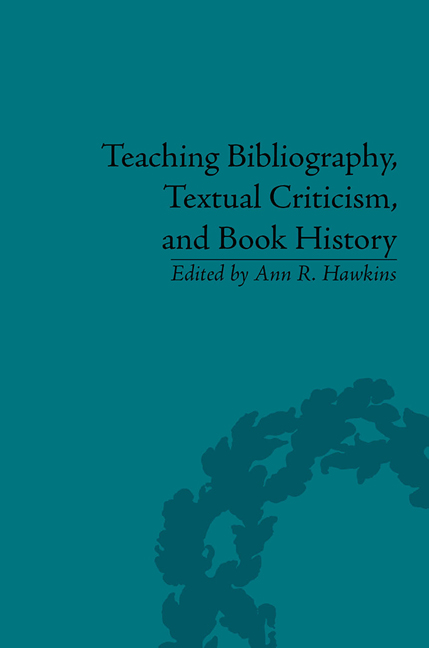Book contents
- Frontmatter
- Contents
- Notes on Contributors
- Foreword
- Introduction: Towards a pedagogy of Bibliography
- Part I Rationales
- Exploring the Archaeology of the Book in the Liberal Arts Curriculum
- Historical Bibliography for Rare-Book Librarians
- ‘A Clear and Lively Comprehension’: The History and Influence of the Bibliographical Laboratory
- Bookends: Towards a Poetics of Material Form
- Part II Creating and Using Resources
- Part III Methodologies
- Teaching ‘History of the Book’
- Teaching Bibliography and Research Methods
- Teaching Textual Criticism
- Part V Resources
- Index
Bookends: Towards a Poetics of Material Form
from Part I - Rationales
- Frontmatter
- Contents
- Notes on Contributors
- Foreword
- Introduction: Towards a pedagogy of Bibliography
- Part I Rationales
- Exploring the Archaeology of the Book in the Liberal Arts Curriculum
- Historical Bibliography for Rare-Book Librarians
- ‘A Clear and Lively Comprehension’: The History and Influence of the Bibliographical Laboratory
- Bookends: Towards a Poetics of Material Form
- Part II Creating and Using Resources
- Part III Methodologies
- Teaching ‘History of the Book’
- Teaching Bibliography and Research Methods
- Teaching Textual Criticism
- Part V Resources
- Index
Summary
Anyone involved with the teaching of book history, bibliography, or textual criticism must, at some point, address both the definition of and our relationship to the book. Guglielmo Cavallo and Roger Chartier have commented that ‘no text exists outside of the physical support that offers it for reading (or hearing) or outside the circumstance in which it is read (or heard). Authors do not write books; they write texts that become written objects’. Yet paradoxically, as robert Escarpit suggests, ‘when we hold it in our hands, all we hold is the paper: the book is elsewhere’. That book is the sum of its textual incarnation, its modes of communication, and its legacy of preservation: that is, the entire constellation of documents and voices which surround and penetrate the permeable membrane of the material form as it moves through time and space. as such, the book is not elsewhere, but everywhere, manifestly present as a reading machine, remaining both transparent and opaque, the vehicle for intellectual content at the same time as inseparable from the individuated and historicized experience of that content. To understand this book, to see the object in its material form, to describe it, and to embed it in a multiplicity of interpretive contexts is paramount.
- Type
- Chapter
- Information
- Publisher: Pickering & ChattoFirst published in: 2014



